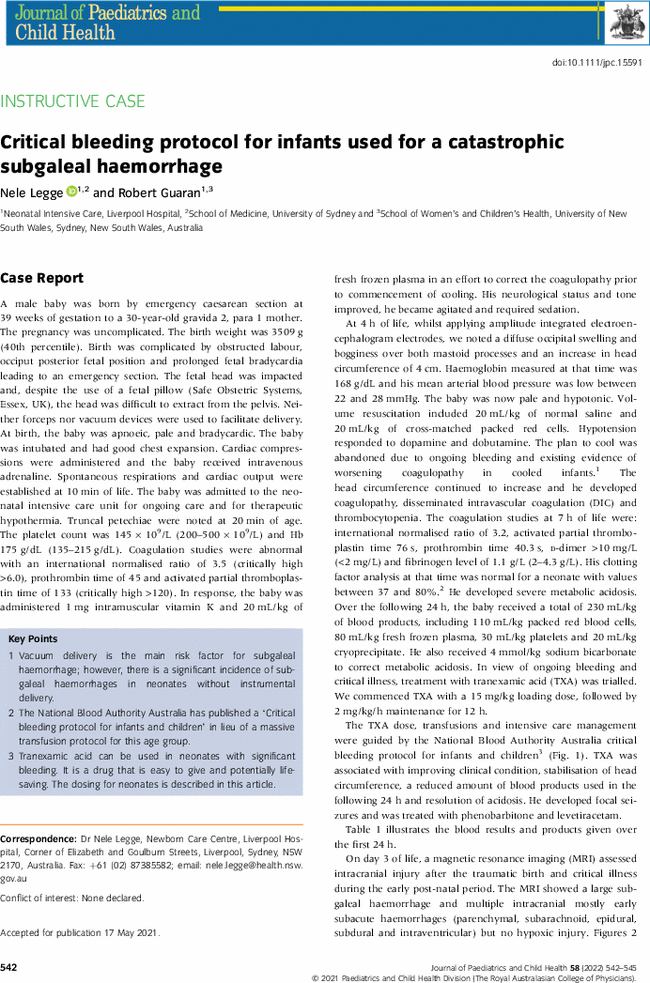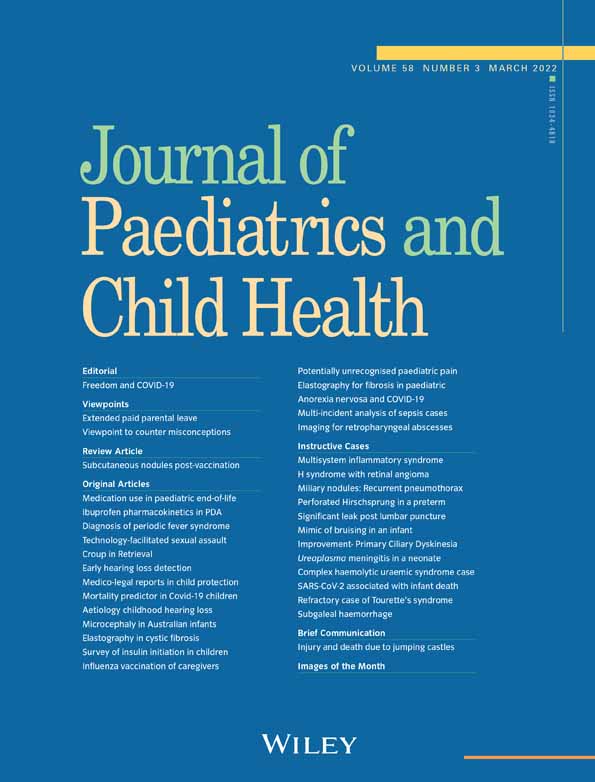Critical bleeding protocol for infants used for a catastrophic subgaleal haemorrhage
Corresponding Author
Nele Legge
Neonatal Intensive Care, Liverpool Hospital, Sydney, New South Wales, Australia
School of Medicine, University of Sydney, Sydney, New South Wales, Australia
Correspondence: Dr Nele Legge, Newborn Care Centre, Liverpool Hospital, Corner of Elizabeth and Goulburn Streets, Liverpool, Sydney, NSW 2170, Australia. Fax: +61 (02) 87385582; email: [email protected]
Search for more papers by this authorRobert Guaran
Neonatal Intensive Care, Liverpool Hospital, Sydney, New South Wales, Australia
School of Women's and Children's Health, University of New South Wales, Sydney, New South Wales, Australia
Search for more papers by this authorCorresponding Author
Nele Legge
Neonatal Intensive Care, Liverpool Hospital, Sydney, New South Wales, Australia
School of Medicine, University of Sydney, Sydney, New South Wales, Australia
Correspondence: Dr Nele Legge, Newborn Care Centre, Liverpool Hospital, Corner of Elizabeth and Goulburn Streets, Liverpool, Sydney, NSW 2170, Australia. Fax: +61 (02) 87385582; email: [email protected]
Search for more papers by this authorRobert Guaran
Neonatal Intensive Care, Liverpool Hospital, Sydney, New South Wales, Australia
School of Women's and Children's Health, University of New South Wales, Sydney, New South Wales, Australia
Search for more papers by this authorConflict of interest: None declared.

References
- 1Smit E, Liu X, Jary S, Cowan F, Thoresen M. Cooling neonates who do not fulfil the standard cooling criteria – Short- and long-term outcomes. Acta Paediatr. 2015; 104: 138–45.
- 2Pal S, Curley A, Stanworth SJ. Interpretation of clotting tests in the neonate. Arch. Dis. Child. Fetal Neonatal Ed. 2015; 100: F270–4.
- 3 National Blood Authority Australia. Patient Blood Management Guidelines: Module 6 - Neonatal and Paediatrics; 2016. Available from: https://www.blood.gov.au/system/files/14523_NBAModule-6-Neonat_Paediatrics_internals_5_updated_14_May_2020.pdf [accessed 29 December 2020].
- 4Chang HY, Peng CC, Kao HA, Hsu CH, Hung HY, Chang JH. Neonatal subgaleal haemorrhage: Clinical presentation, treatment and predictors of poor prognosis. Pediatr. Int. 2007; 49: 903–7.
- 5Arikan AA, Zappitelli M, Goldstein SL, Naipaul A, Jefferson LS, Loftis LL. Fluid overload is associated with impaired oxygenation and morbidity in critically ill children. Pediatr. Crit. Care Med. 2012; 13: 253–8.
- 6Heung M, Wolfgram DF, Kommareddi M, Hu Y, Song PX, Ojo AO. Fluid overload at initiation of renal replacement therapy is associated with lack of renal recovery in patients with acute kidney injury. Nephrol. Dial. Transplant. 2012; 27: 956–61.
- 7Marshall DD, Kotelchuck M, Young TE, Bose CL, Kruyer L, O'Shea TM. Risk factors for chronic lung disease in the surfactant era: A North Carolina population-based study of very low birth weight infants. North Carolina Neonatologists Association. Pediatrics. 1999; 104: 1345–50.
- 8Askenazi DJ, Koralkar R, Hayden E et al. Fluid overload and mortality are associated with acute kidney injury in sick near-term/term neonate. Pediatr. Nephrol. 2013; 28: 661–6.
- 9Reed M, Woolley T. Uses of tranexamic acid. Contin. Educ. Anaes. Crit. Care Pain 2015; 15: 32–7.
10.1093/bjaceaccp/mku009 Google Scholar
- 10Strauss T, Kenet G, Schushan-Eisen I, Mazkereth R, Kuint J. Rescue recombinant activated factor VII for neonatal subgaleal hemorrhage. Isr. Med. Assoc. J. 2009; 11: 639–40.
- 11Thomas S, Sundaram A, Rashid N, Steel M. Recombinant factor VIIa and tranexamic acid in subgaleal hemorrhage. Int. J. Clin. Exp. Dermatol. 2016; 1: 1–2.
- 12 World Health Organization. WHO Recommendation on Tranexamic Acid for the Treatment of Postpartum Haemorrhage. Geneva: WHO; 2017.




